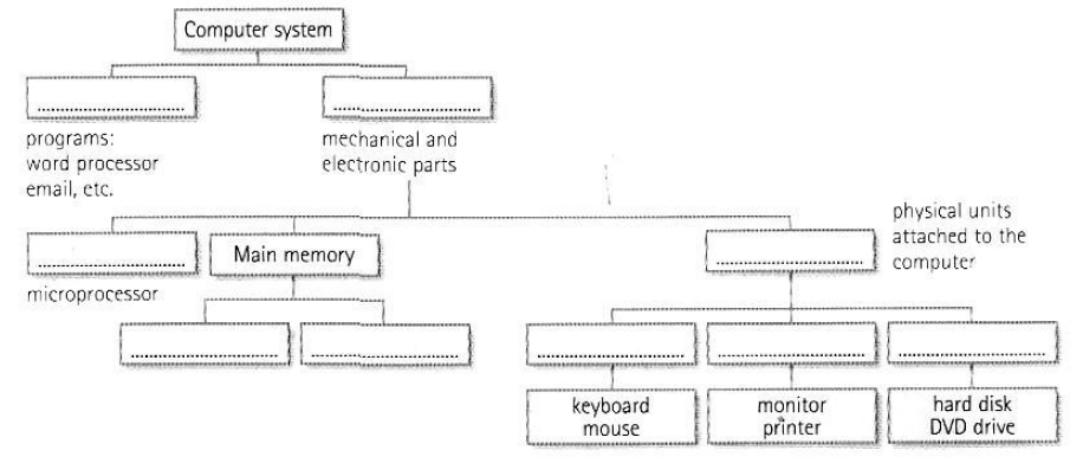
- •Unit 2. Computer essentials
- •1 Reading
- •1.1 Read the text and translate the words in italics into Ukrainian.
- •1.2 Match these words from the text (1-9) with the correct meanings (a-I).
- •1.3 Find the equivalents of the words and word combinations.
- •1.4 State whether these statements are true or false.
- •Make up questions to the words in italics.
- •1.6 Use the information in the text to help you match the terms in the box with the appropriate explanation or definition below.
- •1.7 Read these slogans or quotations, and say what computer element they refer to.
- •1.8 Find words in the slogans with the following meanings.
- •1.9 Translate the sentences into English.
- •2 Vocabulary
- •Look at a. Read these quotations and say which computer essential they refer to.
- •Look at в opposite and label this diagram with the correct terms.
- •2.4 Complete the sentences below with words from c.
- •3 Language work Compound adjectives
- •Find some these noun phrases in the text and explain their meaning as in the help box.
- •Wearable computers, aren’t they chic?
- •Present Progressive (Continuous)
- •Use the present progressive in the sentences below.
- •Translate the sentences into English.
- •3.6 Put the verb in the sentences in the correct tense, Present Simple or Present Continuous.
- •3.7 Circle the correct form of the verb in these sentences.
- •3.8 Complete these sentences, putting the verbs into the correct tense, Present Simple or Present Continuous.
- •3.9 Answer these questions about yourself with соmplete sentences.
Look at в opposite and label this diagram with the correct terms.

2.4 Complete the sentences below with words from c.
1. Computer................................is the visible or audible result of data processing – information that can be read, printed or heard by the user.
2. The CPU will process data as instructed by the programs you're running.................................includes functions like calculating, sorting, editing, drawing and searching.
3. DVDs are expected to replace CDs as................................devices.
4. As a scanner, the Sigma-100 can be used to................................photographs as well as documents into the computer.
3 Language work Compound adjectives
HELP box A compound adjective is made up of two parts and usually describes appearance. The second part is frequently a past participle. e.g. blue-eyed girl = a girl who has got blue eyes sugar-free product = a product that uses no sugar
|
Find some these noun phrases in the text and explain their meaning as in the help box.
Science-based, battery-powered systems, summer-born, program-controlled, hands-free operations, waist-mounted computer, man-created, plastic-coated, virus-damaged, head-mounted display, battery-driven, voice-activated device, man-made, error-protected.
Wearable computers, aren’t they chic?
Can you imagine wearing a PC on your belt and getting e-mail on your eyeglasses? Wearable computers are battery-powered systems worn on the user's body - on a belt, backpack or vest and are designed for mobile or hands-free operation, often incorporating a microphone and a head-mounted display
Some devices are waist-mounted, equipped with a wireless modem, a keypad and a small screen. Others are voice-activated, worn like a scarf and can access e-mail or voice mail.
Users of wearable technology consider themselves 'cyborgs'. This term comes from ‘cybernetic organism’, referring to a being that is part robot, part human.
Present Progressive (Continuous)
We form the present progressive with the present tense of the verb be + -ing. We use the present continuous: • for something that's in progress now, at this moment. Look! It's raining. • for a temporary activity or situation (which may not be in progress at the moment). He's studying engineering at college. • for arrangements we've made for the future. I'm having a party next Saturday. • with always to complain or express surprise/irritation about something that happens frequently. She doesn't get on well with her parents. They're always criticising her. • Certain verbs generally use only simple form, and are not used with the continuous. These are verbs which do not describe activities. They include:
I believe you. I don’t understand. What do you think?
I don’t like him. How do you feel? I want to go. • These verbs can use the present continuous when they become activity verbs: Be quiet, please: I’m thinking. (Here thinking is an activity, like working.) I’m seeing the president tomorrow. (seeing = meeting)
|
